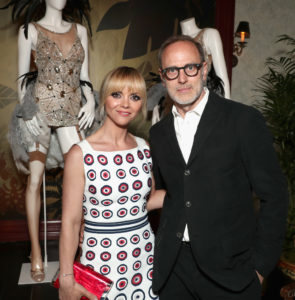
When executive producer and leading actress Christina Ricci first optioned Therese Anne Fowler‘s book, Z: A Novel of Zelda Fitzgerald, she knew she wanted the best department heads to work on her Amazon series–titled, Z: The Beginning of Everything. After much research, it was Ricci’s true intention to clear up misconceptions about Fitzgerald’s storied life that intrigued costume designer, Tom Broecker.
Broecker, a graduate of the Yale School of Drama, is known for his endeavors on both stage and screen, having worked on Broadway on such plays as A Month In The Country, starring Peter Dinklage, as well as David Mamet‘s Race, and Will Ferrell‘s You’re Welcome America: A Final Night with George W. Bush, which toured around the country.
Working behind the scenes at Saturday Night Live proved to be his start in television as Broecker initially served as the series’ assistant costume designer in 1988 and moved up the ranks to costume designer in 1994. Currently, the live show boasts over three hundred episodes with Broecker as costume designer in its credits.
In 2005, Broecker went on to work on thirteen episodes of Lisa Kudrow‘s popular HBO series, The Comeback, and then stayed with that winning team to turn in thirty-five episodes of her follow up show, In Treatment. Two feature films followed for the busy costume designer in 2012, the comedies Girl Most Likely and Joyful Noise.
Somehow, in between projects, Broecker managed to work with Tina Fey on over a hundred episodes of the award winning 30 Rock, where he also occasionally appeared in front of the camera as Lee, the obsessively black clad, intimidating costume designer with no time to spare. He relayed that he loved playing the against type, exasperated, agitated artist.
In preparing for his work on Z: The Beginning of Everything–like most of us, Broecker knew about F. Scott Fitzergerald‘s wife and muse through the popular conception that Zelda was the real life inspiration for the character, Daisy, in the The Great Gatsby. Referencing ideas of what Zelda was like from media of that time, Broecker gathered that America’s first famous flapper was merely a crazy personality, before working with Ricci and the series writer to tell Zelda’s real story from her point of view. From then on, he thought about Fitzgerald’s story and how to represent her true self in terms of seeing life through her distinct lens.
Some of the more challenging aspects of the series was correctly portraying the tricky time period of America in 1917-1920 through costume design. “We don’t tend to do that in-between time period,” Broecker noted. He was of course aware of the suffragettes and the flappers, but it was that interim, transitional time period he needed to fully represent. “Not much survived from this period, unfortunately.” Broecker searched from London to Los Angeles and had some items made in Europe and some made here in the U.S. He worked with the production designers a great deal and adored the palette that was used to bring Lower Manhattan to life, which informed his own designs.
One of the most satisfying aspects of the project was to see the character of Zelda Fitzgerald move from the flowers and ruffles of her Southern heritage to the iconic New York socialite garb she’s known to embody. Although whole periods and seasons were utilized for only a couple episodes, Broecker’s philosophy of “bringing the department store to us,” has proved to be one of the series’ greatest assets thus far. Here’s hoping for a long journey to shine a light on Zelda Fitzgerald’s many true creative contributions to our culture.





